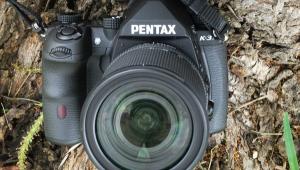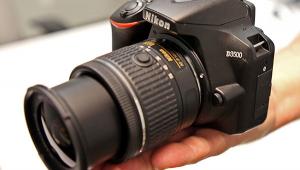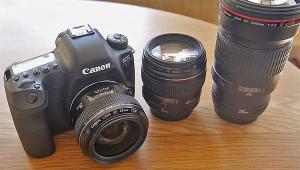Pentax KS-1 DSLR Review
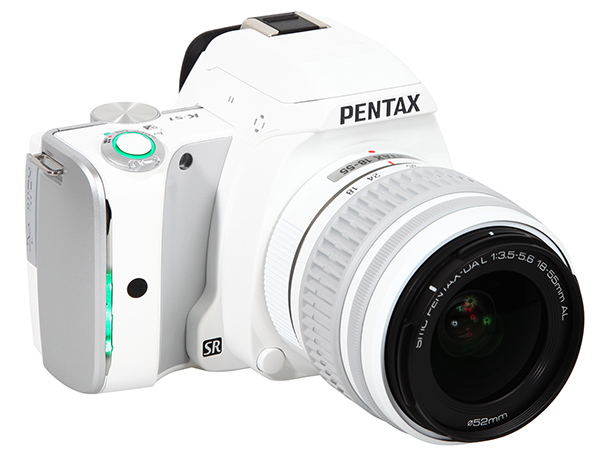
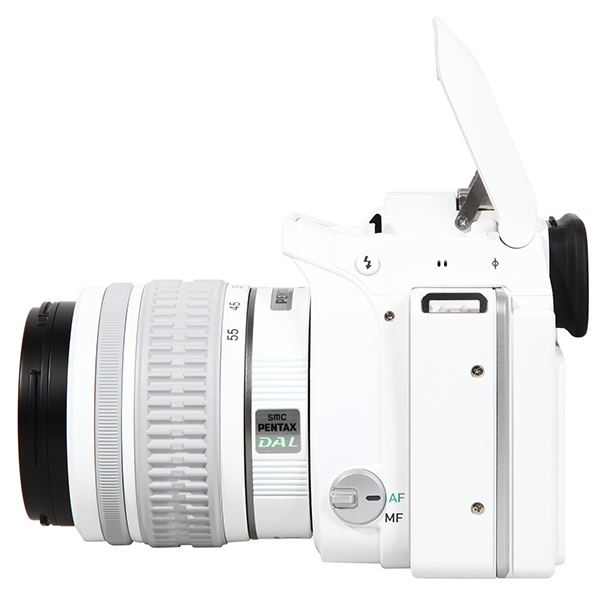

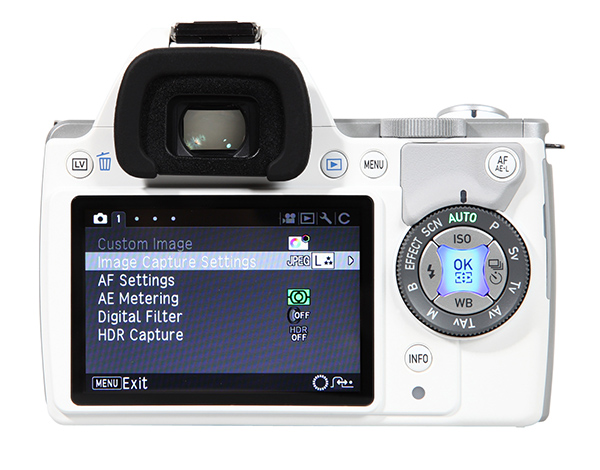
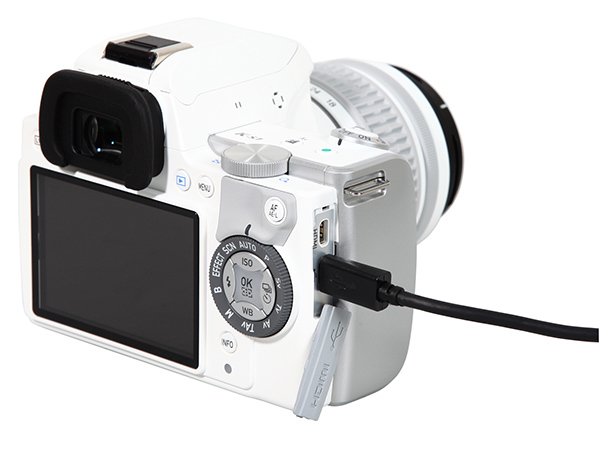
[Editor's Note: Lab test and comments are by Betternet, Shutterbug’s TIPA-affiliated testing lab. TIPA (www.tipa.com) is a worldwide association of photo and imaging magazine editors. Shutterbug is the sole US member of the association, and Editor at Large George Schaub serves as a member of the Technical Committee. Please click on the Image Tech tab on the home page for more camera review tests.]
The Pentax K-S1 is a small but versatile DSLR system with a 20MP APS-C sensor. Its body design is based on a standard DSLR concept, with a large grip on the right hand side and a pentaprism optical viewfinder.
There are, however, some aspects of the camera that are quite unusual, mainly the use of LEDs to signal settings and functions. These LEDs sit on the front and back of the camera and can, for example, show how many people are included in the face detection function; indicate the choice of photo or video mode with a red or green circle of LEDs on the back; or, quite reasonably, indicate self-timer countdown via bright LEDs on the camera front. Whether these LEDs are helpful or not is up to the photographer; fortunately the LED signals can be deactivated via the menu.
While this LED feature can be debated, there are some handling improvements and functions that really are very helpful. The large mode dial on the back, which encircles the 4-way- control field and the illuminated OK button in its center, allows the user to change image modes very quickly and efficiently. Just like all Pentax cameras, the Pentax K-S1 DSLR offers numerous exposure modes. In addition to standards like aperture or shutter speed priority, it offers an additional mode that allows the photographer to choose both parameters manually with the ISO speed setting handled by the automatic exposure system.
The large SCN mode dial allows access to a host of scene modes, including new ones such as “theater stage mode,” “pets,” and even a mode for taking images in the woods.
In addition, the camera offers a lot of digital filter effects like “high contrast black and white”, “vivid colors”, “vintage look” or “IR simulation.”
The camera has a large dial on the top used to change image parameters. Working the mode dial and the setup dial, which both can be reached easily with the right hand thumb, makes for a very comfortable shooting experience.
The optical DSLR viewfinder of the Pentax KS-1 offers a large and bright view of the scene. In contrast to most other entry level DSLRs, the KS1 viewfinder offers a 100 percent field of view. The camera also offers Live View on the LCD screen including a magnifier function when working in manual focus mode or when reviewing images in playback mode.
The KS-1 jas a fast autofocus system with 11 AF sensors (including 9 cross type sensors) that catches even fast moving objects and is helpful in continuous shooting modes. The camera allows the user to take up to 5.4 frames per second, which is a good result for an entry level system (note: this frame rate was confirmed in our tests). Up to 20 frames can be made in the burst (JPEG) resulting in nearly four seconds of continuous shooting, perfect for sport action scenes. Raw mode only drops the rate to 5 frames per seconds. (Note: The camera offers two Raw modes: Pentax PEF or Adobe's DNG file format.)
The new Pentax K-S1 DSLR doesn't offer Wi-Fi functionality, but does support the Pentax FluCard system. “FluCards” are SD storage cards with an integrated WLAN module and allows use of smartphones and tablet computers as wireless remote controls for the camera (including live preview on the LCD screen of the portable device). The FluCard system is also used by Pentax in the medium format 645Z digital camera.
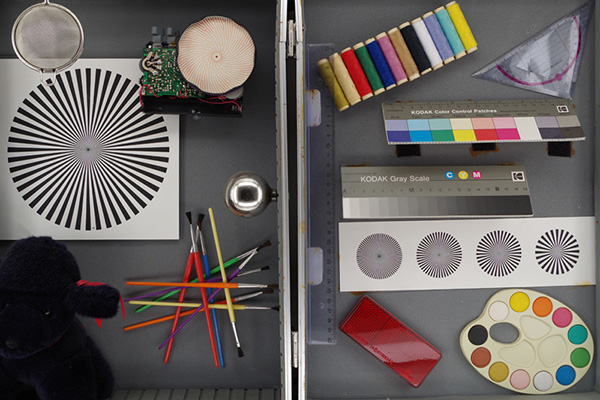
Comments on Image Quality
Color: The default color mode is “Vivid,” which reproduced the test chart with 123.5 percent saturation, an extremely high result. In this default mode darker blue nuances are highly enhanced, which caused the very unusual result in our tests. Skin tones and brighter blue nuances are reproduced more accurately. The white balance system did a really good job and showed a neutral reproduction of the gray pattern in our test charts. The background of the portrait test shot has only a slightly yellow touch, and the gray background of the test box is reproduced very naturally.
Note: Setting the color mode in the menu to “natural” will reduce the exaggerated saturation to a normal level: about 110 percent.

Sharpness: The Pentax K-S1 uses an APS-C sensor without a low pass filter, used to reduce Moiré and aliasing effects by way of a very little blur filtering. So, compared to a standard sensor with identical pixel resolution and low pass filter, the images of the Pentax K-S1 should be crisp and clear. However, the resolution and sharpness tests are a little disappointing. The camera achieved a maximum result of 2799 lines per picture height, while its sensor offers a nominal resolution of 3648 lines per picture height. The unit also uses intense sharpness filtering, which causes clipping effects and high overshot and undershot effects.
Noise: Between ISO 100 and ISO 3200, luminance noise is nearly on the same level as in images taken with other entry-level APS C cameras. At higher ISO speed settings, luminance noise keeps a level of about 1.0 percent, but color noise artifacts become clearly noticeable and annoying. Images taken at ISO 51,200 are quite bad because the camera uses very intense anti-noise filtering, which nearly extinguishes any details. The edges/borders of the single gray pattern in our Stouffer 4110 chart aren't noticeable at ISO 51,200. Up to ISO 12,800, however, the noise and filter artifacts are acceptable.
The dynamic range results are good, but not as good as the results from many other cameras with APS-C sensors. The camera delivered a maximum result of 10.6 f-stops, which is fine, but at higher ISO speed settings it drops below 10 f-stops.
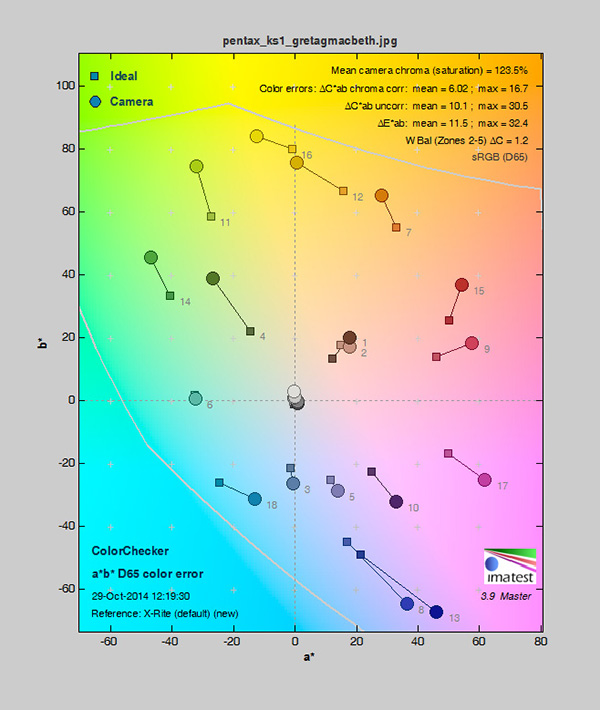
Video Format and Handling
The KS-1 offers Full HD video recording with 1920 x 1080 pixels at a maximum frame rate of 30 frames per second (full frame mode, progressive recording). It also offers PAL compatible mode with 25 frames per second. The camera uses the Apple Quicktime MOV format and H.264 compression to record the video files.
The on/off switch on the top is used to toggle between photo mode and video mode. The camera doesn't have a dedicated video record button, so the standard shutter release button is used to start movie recording when the on/off button is set to “video.” The camera doesn't offer a swivel monitor, which is considered helpful in video recording.
The Pentax allows users to shoot videos in all exposure modes, including aperture priority and shutter priority. The photographer can also choose the ISO setting when the camera is set to M mode. While the camera allows users to shoot stills at ISO 51,200 the video mode is limited to ISO 3200. Some digital image effects can also be used in video mode.
The camera offers an electronic image stabilizer system when recording video. In our tests, it sometimes showed a kind of “wobble” effect, which is similar to software stabilizer functions found in Adobe Premiere, for example.
Sound level is controlled by the camera’s automatic system, but the user can override this up to three levels. The camera doesn't offer a jack for an external microphone.
Comments on Video Quality
The camera reproduced the ISO 12233 test chart with 491 of 1080 lines per picture height, which is a poor result. The very soft look is noticeable in our field recordings. The only advantage of this soft image reproduction we can think of is the prevention of Moiré and aliasing effects.
The camera also showed a poor performance in the dynamic range tests and achieved a maximum of 6.29 f-stops in video mode.
The colors reproduction is good. Just like in photo mode, the colors are highly saturated, especially the blue colors. The white balance system worked well in video mode and generated a neutral color reproduction in various light sources.
Pro
+ compact camera body
+ innovative handling concept; a lot of helpful functions and scene modes for beginners
+ large and bright optical viewfinder; 100% field of view
Con
- image resolution and sharpness a bit disappointing
- missing swivel monitor
Lab test and comments by Betternet, Shutterbug’s TIPA affiliated testing lab. Edited by George Schaub.


